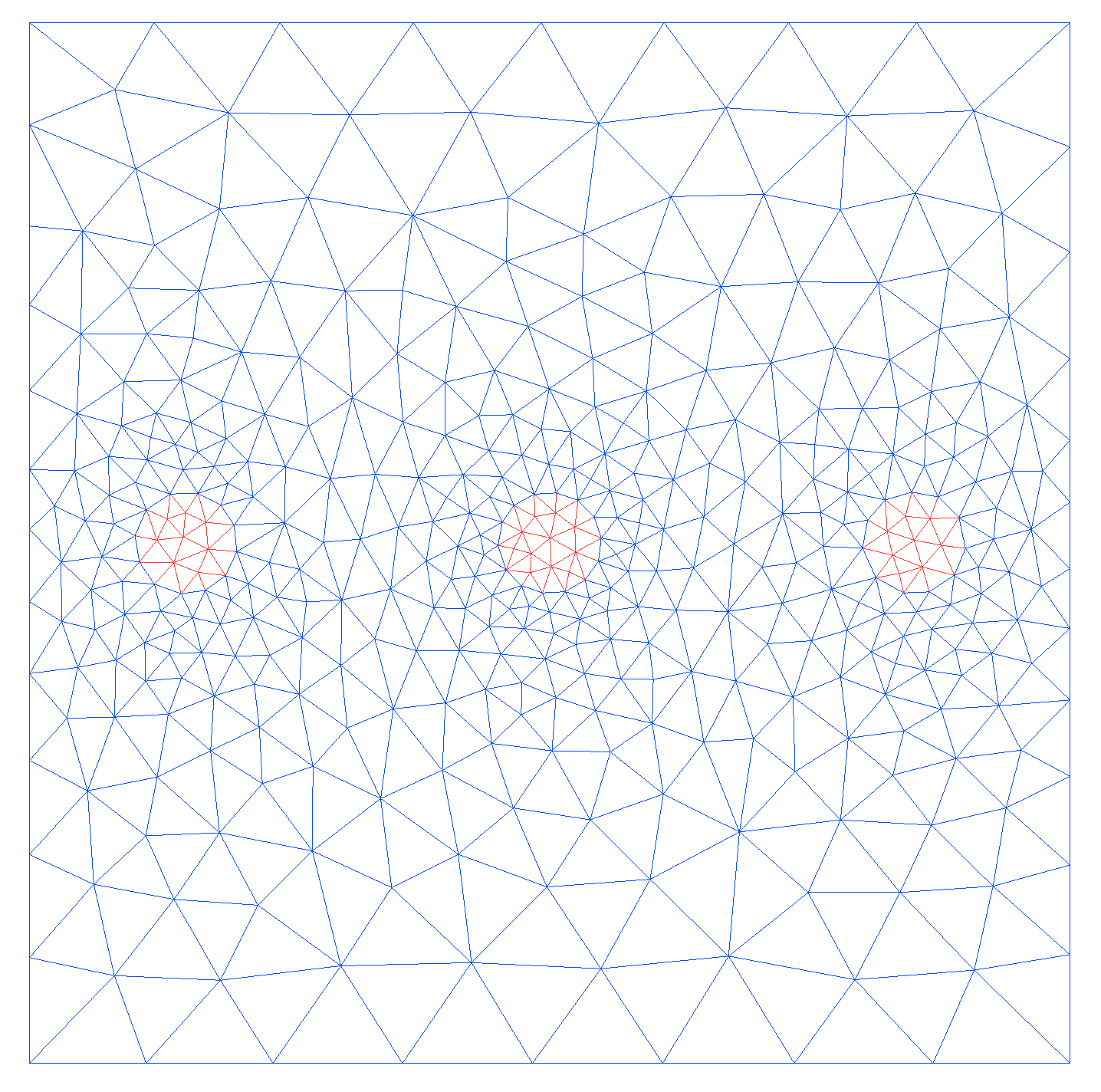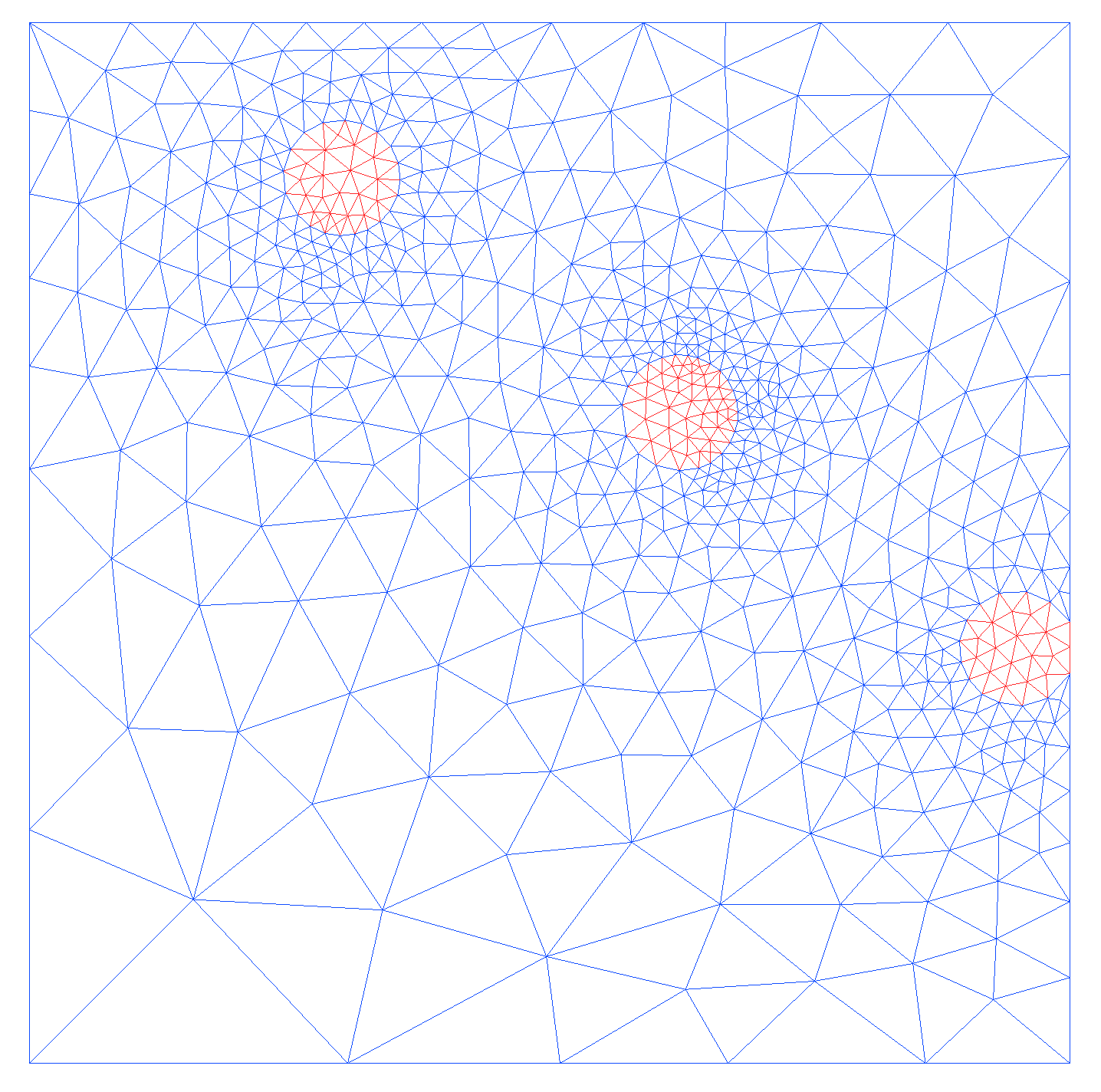Creation of objects inside a meshed geometry
1. Formulation
The aim of this application is to insert objects of complex shape in meshed fluid domains, in order to simulate the fluid-body interaction.
The MMG platform [MMG] provides a functionality that allows to discretize a surface defined by a level-set function, i.e. to create an explicit mesh from a meshed geometry and a discrete level-set function at the mesh nodes, defining the boundary of an object. To better understand this functionality, we will give a simple example. When considering the discretization of a square and the level-set function of a centered circle, then the explicit mesh is given by:

In order to use this functionality in our application, we need to perform some preliminary operations. First, the object is rotated, scaled and translated to localized it in the desired position in the meshed geometry. Then, we determine the level-set function of the object using the Fast Marching method detailed in section (Repulsive force for arbitrary rigid bodies). Finally, we interpolate the level-set function of the object on the meshed geometry, to define it on each mesh node of the domain.
2. Algorithm
We have implemented this application in \(d = 2\) and \(d = 3\) dimensions. The main steps are given by the following algorithm:
\begin{algorithm}
\caption{Algorithm for creation of objects inside a meshed geometry}
\begin{algorithmic}
\Require Discretization of fluid domain $\Omega$ and rigid object $B$.
\STATE \Comment{Step 1 : Load mesh of rigid object $B$ and rotate, scale and translate mesh nodes $n_i$}
\STATE - Define $\vec{t}$ translation vector, $\theta$ rotation angle and $\lambda$ scaling parameter
\STATE - Compute $R(\theta)$ rotation matrix
\STATE - $n_i \leftarrow \vec{t} + \lambda [ R(\theta) n_i ]$
\STATE \Comment{Step 2 : Build level-set function $\phi$}
\STATE - Get boundary markers of $B$, denoted $\mbox{markersBoundary}$
\STATE - $\phi \leftarrow $ distanceToRange(markersBoundary)
\STATE \Comment{Step 3 : Interpolate $- \phi$ onto $\Omega$ to get $\psi$}
\STATE - Define constant function $\psi$ over $\Omega$ : $ \psi \leftarrow \mbox{project}(\Omega,cst)$
\STATE - $\psi \leftarrow \mbox{interpolate}(-\phi,\psi)$
\STATE \Comment{Step 4 : Remesh using MMG functionality}
\STATE - $\Omega$ is the meshed geometry and $\psi$ contains the level-set function on each mesh node.
\end{algorithmic}
\end{algorithm}
This algorithm allows to obtain the explicit mesh, however one has to add two steps to get an efficient algorithm. First, the MMG remeshing does not preserve the boundary markers. Thus, the object markers, which are required during the simulation of the fluid-body interaction, are removed and one has to find a method to redefine them. Second, for the examples shown in the next paragraph, the MMG executable was used to do the remeshing. It would be useful to implement this function, to avoid creating files containing the mesh and level-set function data.
3. Examples
For the following two examples, we consider a mesh square as fluid domain. We want to insert the aligned three-sphere swimmer into this mesh. The swimmer is given by:

First, we do not transform the nodes coordinates of the swimmer’s mesh, but we directly compute its level-set function and apply the interpolation. The explicit mesh obtained with MMG is given by:

As we get the right result, we add the rotation, scaling and translation of the mesh nodes. The following figure shows that we can define the position of the swimmer in the square.

References on collision models
-
[Glowinski] R. Glowinski, T. W. Pan, T. I. Hesla, D. D. Joseph, and J. Périaux (2000). A Fictitious Domain Approach to the Direct Numerical Simulation of Incompressible Viscous Flow past Moving Rigid Bodies: Application to Particulate Flow. Download PDF
-
[AIP_Advances] K. Usman, K. Walayat, R. Mahmood, et al. (2018). Analysis of solid particles falling down and interacting in a channel with sedimentation using fictitious boundary method. Download PDF
-
[Computers_Fluids] L. Wang, Z.L. Guo, J.C. Mi (2014). Drafting, kissing and tumbling process of two particles with different sizes. Download PDF
-
[Wan_Turek] Decheng Wan and Stefan Turek (2004). Direct Numerical Simulation of Particulate Flow via Multigrid FEM Techniques and the Fictitious Boundary Method. Download PDF
-
[Multiphase_Flow] P. Singh, T.I Hesla, D.D Joseph (2002). Distributed Lagrange multiplier method for particulate flows with collisions.
-
[Settling_ellipsoid] Tsorng-Whay Pan, Roland Glowinski, Giovanni P.Galdi (2001). Direct simulation of the motion of a settling ellipsoid in Newtonian fluid. Download PDF
-
[FMM_1] J.A. Sethian (1996). A fast marching level set method for monotonically advancing fronts.
-
[FMM_2] J.A. Sethian (1996). Level Set Methods and Fast Marching Methods; Evolving Interfaces in Computational Geometry, Fluid Mechanics, Computer Vision and Materials Sciene.
-
[FMM_3] J.A. Sethian. Level Set Methods and Fast Marching Methods.
-
[CollisionModel_DNS] Ramandeep Jain, Silvio Tschisgale, Jochen Fröhlich (2019). A collision model for DNS with ellipsoidal particles in viscous fluid.
-
[DNS_Framework] S.Tschisgale, T.Kempe and J.Fröhlich (2018). A general implicit direct forcing immersed boundary method for rigid particles.
-
[Wu_Shu] J.Wu, C.Shu (2009). Particulate Flow Simulation via a Boundary Condition-Enforced Immersed Boundary-Lattice Boltzmann Scheme.
-
[Stenotic_artery] H.Li, H.Fang, Z.Lin, S.Xu, S.Chen (2004). Lattice Boltzmann simulation on particle suspensions in a two-dimensional symmetric stenotic artery.
-
[Collision_simulations] L.H. Juarez, R. Glowinski, T.W. Pan (2004). Numerical Simulation of Fluid Flow with Moving and Free Boundaries. Download PDF
-
[Collision_ellipticalParticle] Zhenhua Xia, Kevin W. Connington, Saikiran Rapaka, Pengtao Yue, James J. Feng, Shiyi Chen (2008). Flow patterns in the sedimentation of an elliptical particle. Download PDF
-
[Sphere_interaction] S.M. Dash, T.S. Lee (2015). Two spheres sedimentation dynmics in a viscous liquid column.
-
[MMG] www.mmgtools.org/mmg-remesher-try-mmg/mmg-remesher-tutorials/mmg-remesher-mmg2d/implicit-domain-meshing.
 .pdf
.pdf